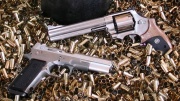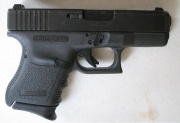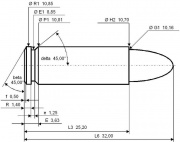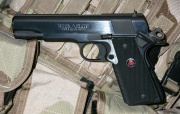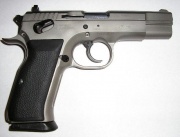10mm Auto
| 10mm Auto | ||||||||||||||||||||||
|---|---|---|---|---|---|---|---|---|---|---|---|---|---|---|---|---|---|---|---|---|---|---|
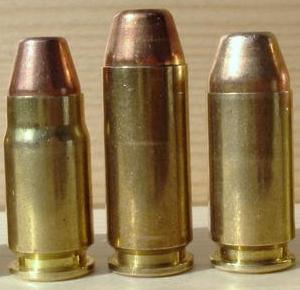
| ||||||||||||||||||||||
| Left to right: .357 SIG, 10mm Auto, .40 S&W | ||||||||||||||||||||||
| Type | Pistol | |||||||||||||||||||||
| Country of Origin | Sweden / USA | |||||||||||||||||||||
| Specifications | ||||||||||||||||||||||
| Case Type | Rimless, straight | |||||||||||||||||||||
| Bullet Ø | 10.16 mm (0.400 in) | |||||||||||||||||||||
| Neck Ø | 10.70 mm (0.421 in) | |||||||||||||||||||||
| Base Ø | 10.81 mm (0.426 in) | |||||||||||||||||||||
| Rim Ø | 10.85 mm (0.427 in) | |||||||||||||||||||||
| Rim Thickness | 1.40 mm (0.055 in) | |||||||||||||||||||||
| Case Length | 25.20 mm (0.992 in) | |||||||||||||||||||||
| Full Length | 32.00 mm (1.260 in) | |||||||||||||||||||||
| Rifling twist | 381 mm (1 in 15 in) | |||||||||||||||||||||
| Primer | Large pistol | |||||||||||||||||||||
| Max. pressure | 258.55 MPa (37,500 psi) | |||||||||||||||||||||
| Production & Service | ||||||||||||||||||||||
| Designer | FFV Norma AB | |||||||||||||||||||||
| Design Date | 1984 | |||||||||||||||||||||
| Production Dates | 1984 to present | |||||||||||||||||||||
| Ballistic Performance Sampling | ||||||||||||||||||||||
| ||||||||||||||||||||||
Although it was selected by the FBI for use in the field, their Firearms Training Unit "concluded that its recoil was excessive in terms of training for average agent/police officer competency of use and qualification," and the pistols that chambered it were too large for some small-handed individuals.[3] These issues led to the creation and eventual adoption by the FBI of a shortened version of the 10mm.
Although respected for its stopping power, scarcity and high prices have made the 10mm a niche cartridge, with a small but enthusiastic group of supporters.
Contents[hide] |
[edit] History
The 10mm Auto cartridge was championed by famous firearms expert Jeff Cooper. It was designed to be a medium velocity pistol cartridge with greater stopping power than the 9x19mm and better external ballistics (i.e., flatter trajectory, greater range) than the .45 ACP. When Norma designed the cartridge, at the behest of Dornaus & Dixon for their Bren Ten pistol (a strengthened variant of the CZ-75), they decided to increase the power over Cooper's original concept. The resulting cartridge, introduced in 1983, is very powerful, packing the flat trajectory and high energy of a magnum revolver cartridge into a relatively short, rimless cartridge for an automatic pistol.
Despite its supporters, it has generally failed to gain popularity because the full-powered loads have too much recoil and blast for many people's tolerances. Additionally, its reduced loads can be duplicated in smaller guns using the less expensive .40 S&W cartridge. In its lighter loadings it is an exact duplicate of the popular .40 S&W cartridge, in its medium loadings it can equal or exceed the performance of the .357 Magnum. It can exceed .45 ACP performance for equivalent bullet weights. With full-power loads and heavy bullets, it may be used as a deer, bear, or boar hunting cartridge.
The 10mm fires its bullet at high velocity, giving it a less-curved flight path and less drop or rise above point-of-aim compared to many other handgun cartridges, and thus is often described as "flat-shooting." Its outside diameter is also somewhat smaller than the .45 ACP and therefore offers the potential for greater capacity in a comparably-sized magazine. These characteristics also allow it to be used as a sub-machine gun cartridge, with H&K offering their MP5 platform in the cartridge.
The 10mm Auto has never had large-scale popularity; nonetheless many feel that it is an excellent cartridge. It earned a reputation for battering guns early on, largely because manufacturers attempted to simply rechamber a .45 ACP design for the 10mm Auto. The .45 ACP works at a much lower pressure and velocity, and the frame and slide designed to handle the .45 ACP cannot handle the greatly increased forces of a 10mm Auto without substantial strengthening. Later guns (most notably the Glock 20, Glock 29 and the Smith & Wesson 1006) were built around the 10mm and, if properly cared for, work reliably for many years and thousands of rounds.
Another issue with early acceptance was the result of manufacturing problems with the Bren Ten. The contractor who was to manufacture the magazines had problems delivering them on time, and many early Bren Tens were shipped to dealers and customers without magazines. This, combined with the high price of the Bren Ten (MSRP in 1986 was US$500), caused the company to cease operations in 1986, after only three years of manufacture. Had not Colt made the rather surprising decision to bring out their Delta Elite pistol, a 10mm Auto version of the venerable Government Model, in 1987, the cartridge might have sunk into obsolescence, an obscure footnote in firearms history.
Thanks to media exposure (primarily in the television series Miami Vice), demand for the Bren Ten increased after production ceased. In the five years after production ceased, prices on the standard model rose to in excess of US$1400, and original Bren magazines were selling for over US$150 (Blue Book of Gun Values, S. P. Fjestad, 13th edition, 1992).
The FBI adopted the 10mm Auto round in the late 1980s along with the S&W model 1076 (a short barreled version of the 1026 with a frame-mounted decocker). During testing of a new service caliber, the FBI concluded that the full power of the load would result in undesirable recoil. The FBI then submitted a requirement for a reduced-recoil loading. This later became known as the "10 Lite", or "10mm FBI" load. Pistol reliability problems increased with this lighter load and Smith and Wesson saw this as an invitation to create something new: a shortened version of the 10mm. This new round was called the .40 Smith and Wesson. The .40 S&W would function in a 9 mm-sized pistol; the advantage was that smaller-handed shooters could now have a 9 mm-sized gun with near-10mm performance. The .40 S&W has become the most popular handgun caliber among law enforcement agencies in the US, while the 10mm Auto has all but disappeared outside the hands of the hobbyist. Still, some 10mm loyalists refer to the .40 S&W as ".40 Short and Weak".[4][5].Glock, Wilson Combat, Kimber Manufacturing, Dan Wesson Firearms, and Tanfoglio are some of the few manufacturers that still offer handguns in 10mm Auto.
The 10mm outperforms the .40 S&W by 200-250 ft/s for similar bullet weights when using available full power loads,[6] as opposed to the "10mm FBI" level loads still found in some ammunition catalogs.[7][8] This is due to the 10mm Auto's higher SAAMI pressure rating of 37,500 psi,[2] as opposed to 35,000 psi for the .40 S&W,[2] and the larger case capacity, which allows the use of heavier bullets and more smokeless powder.
Since its introduction, the 10mm Auto has had a reputation for accuracy which the shorter cartridge seems unable to match. Recently, it has had a small resurgence in popularity, but ammunition can still be more expensive and harder to find than the common .40 S&W. Most avid 10mm shooters today are handloading, because the price of factory-loaded ammunition may go as high as US$37 for 25 rounds. Companies such as Remington and DoubleTap Ammunition have begun offering full power 10mm Auto loads in "common" price ranges ($25-$30 for 50 rounds). Factory reloads are still being produced, and are carried by popular shooting ranges.
[edit] Cartridge dimensions
The 10mm Auto has 1.56 ml (24 grains H2O cartridge case capacity.10mm Auto maximum C.I.P. cartridge dimensions.[1] All sizes in millimeters (mm).
The common rifling twist rate for this cartridge is 381 mm (1 in 15 in), 5 grooves, Ø lands = 9.91 mm, Ø grooves = 10.16 mm, land width = 4.47 mm and the primer type is large pistol.
According to the official C.I.P. (Commission Internationale Permanente Pour L'Epreuve Des Armes A Feu Portative) guidelines the 10mm Auto case can handle up to 230 MPa (33,358 psi) piezo pressure. In C.I.P. regulated countries every pistol cartridge combo has to be proofed at 130% of this maximum C.I.P. pressure to certify for sale to consumers.
The SAAMI pressure limit for the 10mm Auto is set at 258.55 MPa (37,500 psi), piezo pressure.[9]
The American .41 Remington Magnum cartridge is probably the closest ballistic twin of the 10mm Auto. The . 41 Remington Magnum is however a rimmed cartridge.[10]
[edit] Performance
The 10mm Auto falls between the .357 Magnum and the .41 Magnum in muzzle energy for popular loadings. With certain JHP bullets, these energy levels may produce an effect known as hydrostatic shock in living targets.[11][12][13][14][15][16][17] The existence of this phenomenon has been questioned, however. [18][19][20] Some commercial loadings are as follows: .357 Mag: .357 Mag: 584 ft·lbf (792 J) for 125 gr (8.1 g) @ 1,450 ft/s (440 m/s); 10mm: 750 ft·lbf (1,020 J) for 200 gr (13 g) @ 1,300 ft/s (400 m/s);[21] .41 Mag: 788 ft·lbf (1,068 J) for 210 gr (14 g) @ 1,300 ft/s (400 m/s). The 10mm load given is about maximum for SAAMI established pressure levels, while the .357 and especially the .41 Magnums are commonly handloaded to significantly higher levels than these samples. Recoil energy of full-power loads is also comparable, being 9.4, 12.4, and 15.6 ft·lbf (21.2 J) respectively for these loads (computed using the same powder and weight of gun). The 10mm Auto may be used for deer or other medium game at short range. Ted Nugent is known for using a Glock 20 with an extended barrel when hunting wild boar.
Most 10mm handguns are not designed for long range shooting often desired in hunting; a few revolvers (using half-moon clips to adapt the cartridge) are made in this chambering, and offer another choice for hunters. Much currently manufactured 10mm ammunition is closer in performance to the "FBI load" than the full power 10mm; these still offer sufficient power for defense applications, yet their recoil is more comparable to the .45 ACP in similar guns. A few smaller companies offer full-power ammunition for this chambering. Due to the less common availability and higher than average cost of commercial ammunition, it is more a handloader's cartridge than most other popular auto pistol rounds. 10mm Auto ammunition should be available in a well stocked shooting retailer, though it is less likely to be stocked than more popular defensive calibers. Major ammunition companies do produce ammunition, and it is readily available through special order.
The 10mm Auto cartridge operates at very high pressure in comparison to other defensive pistol cartridges, such as the .38 Special or the .45 ACP. Its maximum average pressure of 37,500 psi is closely comparable to that of the .357 Magnum or the .44 Magnum,[22] allowing it to develop higher velocities. The original loading was a 200 grain (13 g) bullet at 1200 ft/s (366 m/s), yielding 635 ft•lbf (861 J) of kinetic energy at the muzzle. The 10mm is able to match or exceed both .357 Magnum and .45 ACP performance in similar bullet weights.
[edit] Usage
The 10mm Auto is suitable for hunting medium-sized game at moderate ranges, is certainly more than adequate for defensive or tactical use, and is one of the few true semi-automatic, rimless cartridges that is legal for hunting whitetail deer in many US states.
Today, the 10mm Auto cartridge is generally used to fend off medium-sized dangerous animals, as a high-powered defensive handgun, and for hunting, especially by those who prefer the flatter carry profile and higher cartridge capacity of an automatic pistol versus a magnum revolver. It makes Major ranking in IPSC, even in lighter loadings.
Despite the FBI switching to the .40 S&W, there are still a number of law enforcement agencies that issue the 10mm including the Albuquerque J.P.D., the Anniston, Alabama P.D., and the Billings, Montana P.D.
[edit] Synonyms
- 10mm Bren Ten
- 10mm Norma
- 10mm FBI
- 10x25mm
- The Centimeter (this name is also used to refer to a wildcat cartridge based on the 10mm Auto, which is trademarked by Pistol Dynamics[23])
[edit] See also
[edit] References
- ↑ 1.0 1.1 C.I.P. decisions, texts and tables - free current C.I.P. CD-ROM version download (ZIP and RAR format)
- ↑ 2.0 2.1 2.2 SAAMI pressure specs
- ↑ The 10mm Auto Cartridge, quoting Shooting Times, "The Rise & Fall of the 10mm," by Dick Metcalf, November 1999
- ↑ Guns Magazine article using the term "Short and Weak"
- ↑ American Handgunner Magazine article using the term "Short and Weak"
- ↑ Ballistics information on DoubleTap Ammo's full-power 180 gr (12 g). 10 mm load
- ↑ Ballistics information on Federal's "10mm Lite" style American Eagle 180 gr (12 g). 10 mm load
- ↑ Ballistics information on Federal's American Eagle 180 gr (12 g). .40S&W load
- ↑ SAAMI Pressures
- ↑ The .40 somethings: often compared to one another, the cruiserweight .41 Magnum and 10mm rounds aren't truly equal but have much in common - Guns Magazine, May, 2008 by Massad Ayoob
- ↑ Scientific Evidence for Hydrostatic Shock
- ↑ Göransson AM, Ingvar DH, Kutyna F: Remote Cerebral Effects on EEG in High-Energy Missile Trauma. The Journal of Trauma. 28(1 Supplement):S204-S205; January 1988.
- ↑ Suneson A, Hansson HA, Seeman T: Pressure Wave Injuries to the Nervous System Caused by High Energy Missile Extremity Impact: Part I. Local and Distant Effects on the Peripheral Nervous System. A Light and Electron Microscopic Study on Pigs. The Journal of Trauma. 30(3):281-294; 1990.
- ↑ Suneson A, Hansson HA, Seeman T: Pressure Wave Injuries to the Nervous System Caused by High Energy Missile extremity Impact: Part II. Distant Effects on the Central Nervous System. A Light and Electron Microscopic Study on Pigs. The Journal of Trauma. 30(3):295-306; 1990.
- ↑ Wang Q, Wang Z, Zhu P, Jiang J: Alterations of the Myelin Basic Protein and Ultrastructure in the Limbic System and the Early Stage of Trauma-Related Stress Disorder in Dogs. The Journal of Trauma. 56(3):604-610; 2004.
- ↑ Sturtevant B, Shock Wave Effects in Biomechanics, Sadhana, 23: 579-596, 1998.
- ↑ Courtney A, Courtney M. Links between traumatic brain injury and ballistic pressure waves originating in the thoracic cavity and extremities. Brain Injury 21(7): 657-662, 2007.
- ↑ The Shockwave Myth Fackler ML: Literature Review and Comment. Wound Ballistics Review Winter 1991: pp38-40.
- ↑ Patrick UW: Handgun Wounding Factors and Effectiveness. FBI Firearms training Unit, Quantico, VA. 1989.
- ↑ MacPherson D: Bullet Penetration—Modeling the Dynamics and the Incapacitation Resulting From Wound Trauma. Ballistics Publications, El Segundo, CA, 1994.
- ↑ Source
- ↑ SAAMI pressure specs
- ↑ Welcome to Pistol Dynamics
